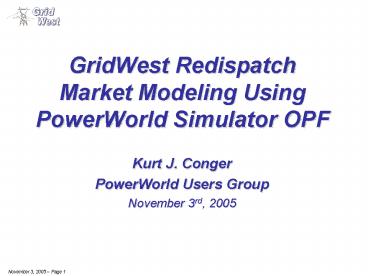GridWest Redispatch Market Modeling Using PowerWorld Simulator OPF - PowerPoint PPT Presentation
1 / 17
Title:
GridWest Redispatch Market Modeling Using PowerWorld Simulator OPF
Description:
November 3, 2005 Page 1. GridWest Redispatch Market Modeling ... 6. Eliminating Rate Pancakes. 36. 119. 203. 17. 58. 98. 5. Power Delivery System Reliability ... – PowerPoint PPT presentation
Number of Views:43
Avg rating:3.0/5.0
Title: GridWest Redispatch Market Modeling Using PowerWorld Simulator OPF
1
GridWest Redispatch Market Modeling Using
PowerWorld Simulator OPF
- Kurt J. Conger
- PowerWorld Users Group
- November 3rd, 2005
2
Market and Operational Functions
3
Estimate of Quantifiable Benefits
(All figures in million/year)
Included in the 10-control-area consolidation
are the control areas of Avista Corporation, B.C.
Transmission Corporation, Bonneville Power
Administration, Idaho Power Company, NorthWestern
Energy, PacifiCorp (east and west), Portland
General Electric, Puget Sound Energy, Inc., and
Sierra Pacific Power.
4
Redispatch Efficiencies
- What is the effect of changing the system control
topology and implementing Real-time Balancing
Service (RBS)? - Study Hypothesis
- By consolidating control area operations and
creating a market for real-time balancing energy,
Grid West can achieve lower hourly, system-wide
production costs than multiple autonomous control
areas. - Basis for Study
- Measure of benefits determined by comparing
dispatch costs of multiple, autonomous control
areas with various consolidated control area
configurations. - Implementation of Grid West Real-time Balancing
Service (RBS) - Redispatch market within CCA utilizing all
physically available transmission system
capability (security constrained economic
dispatch) - Eliminating real-time area-to-area schedule
constraints within the CCA no Scheduled
Interchange within consolidated areas - Larger pool of generating resources available for
real-time dispatch - Flow-based, netting, reduction of transmission
reserve margin (TRM), Capacity Benefit Margin
(CBM)
5
Interchange Schedule Input Values, Factors for
Consideration and Constraints
- Power and transmission contracts rights,
interpretation and use - Contract Path Point-to-Point type 888 Tariff
Schedules - NERC, WECC, NWPP and other scheduling rules
- Bilateral energy trades
- Capacity margins (e.g., Capacity Benefit Margin,
Transmission Reserve Margin) - Transmission rights held for flexibility and for
hedging outage performance - WSPP bilateral wholesale power products
- Treatment of load forecast error and risk
- Planned maintenance (transmission and
generation-if known) - Unit Commitment plans
- Pricing of transmission
- Reserves
- Treatment of weather forecasts and other external
factors - Assumptions of other operational conditions,
e.g., loopflow (inadvertent flows)
6
Modeling Process
- Gen Op by CA
- Actual Flows
- Actual Losses
- Fuel Production
- Cost
- LMPs
- Unit Commitment
- Dynamic Schedules
- Sched. Interchange
Delivered Power Costs to Customers
Flow Based Least Cost Security Constrained
Dispatch PowerWorld Optimal Power Flow
Simulator
- Settlement
- Allocation
- Billing
- Revenues
- Rates
Fixed Costs, Contract Costs, Trades
7
Base Case Description
- 4 Seasons, light-load and heavy-load hour WECC
operating cases used for individual control area
to control area schedules and net scheduled
interchange. - June 14, 2004 disturbance case used as the
spring, LLH case, based upon actual interchange
schedules. - These cases were used to analyze performance over
a typical year.
8
Grid West CasesConsolidated Control Area Cases
- 4 Control Areas Consolidated
- BPA
- PAC East
- PAC West
- Idaho Power Company
- 10 Control Areas Consolidated
- BPA, Idaho, PACW, PACE, Avista, British Columbia
Transmission Corporation, NorthWestern Energy,
Portland General Electric, Puget Sound Energy
and, Sierra Pacific.
9
Case Assumptions
- WECC max/min generator limits
- WECC data reflects actual interchange schedules
- Attempted to replicate actual operations (e.g.,
dynamic schedules, discretionary and non-
discretionary hydro dispatch) - SSG-WI and RMATs variable costs for thermal
units. - Gas price range 5.84 to 7.22 per MMBtu
(approx. 50 per MWh weighted average) - Coal marginal cost range 5 to 27 per MWh
(approx. 12 per MWh weighted average) - Sensitivities on Hydro opportunity costs (20
30 40 50 65/MW-hour Dow Jones average
Mid- C and weighted average)
10
Modeling Approach PowerWorld Simulator
- Time domain simulation of electric power grid
- Models defined for a representative one-hour
period - Topology changes to WECC operating cases
- Separated WECC Northwest Area into separate
control areas - Added flowgates and detailed path ratings
- Created zones defined by flowgates
- Modeled dynamic schedules, e.g. Mid-C unit
allocations - Load following scheduled most hydro in the CCA
(limited amount of hydro available for Real-time
Balancing Service) - Solves Optimal Power Flow in individual Control
Areas while holding Net Scheduled Interchange
constant as a proxy for actual Control Area
generation dispatch (AGC) - Economic Dispatch constrained by system physical
limits WECC path ratings, system element limits,
voltage schedules - Modeled both individual control areas (base
cases) or consolidated control areas (change
cases)
11
(No Transcript)
12
Production Cost Savings v. Hydro Opportunity Cost
4 CCA Cases
13
Historical Price Probability Data
Source Clearing Up 1197
14
Recent Price Probability Data
Source Clearing Up 1197
15
Price Frequencies for Annualization
2004 Data Series HLH 16 hrs/day
16
Resulting Product Annualized Production Cost
Savings
2004 Data Series HLH Example
17
Redispatch EfficiencyBenefit Estimates































